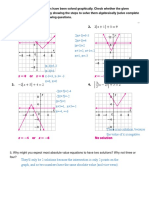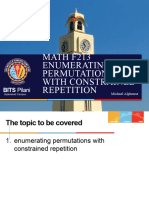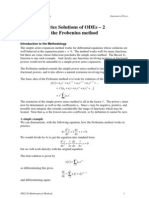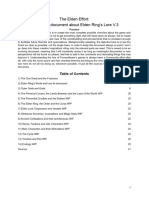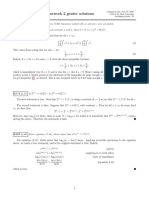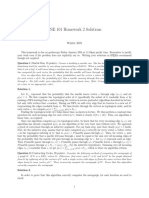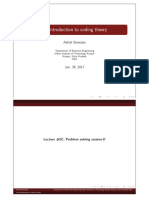CSE 101 Homework 0 Solutions: Winter 2021
Uploaded by
Hoang NguyenCSE 101 Homework 0 Solutions: Winter 2021
Uploaded by
Hoang NguyenCSE 101 Homework 0 Solutions
Winter 2021
Question 1 (Program Runtimes, 20 points). Consider the following programs:
Alg1(n):
For i = 1 to n
j = 1
while j < n
j = j+1
Alg2(n):
For i = 1 to n
j = 1
while j < n
j = j+i
For each of these algorithms, compute the asymptotic runtime in the form Θ(−).
Solution 1.
Alg1: Each iteration of the for loop involves Θ(n) operations, as j is always incremented n − 1 times. There
are n iterations of the for loop, so our total runtime is n ∗ Θ(n) = Θ(n2 ) .
n
Alg2: In each iteration of the for loop, Pnj is incremented
Pn Θ( i )1 times. i iterates from 1 to n, th
so our total
n n n
runtime is Θ(n) + Θ( 2 ) + Θ( 3 ) + · · · = i=1 Θ( i ) = n · i=1 Θ( i ). The summation is just the n harmonic
number Hn , and Hn = Θ(log n), so our total runtime is Θ(n log n) .
Question 2 (Big-O Computations, 20 points). Sort the functions below in terms of their asymptotic growth
rates. Which of these functions have polynomial growth rates? Remember to justify your answers.
• a(n) = n + n1/2 + n1/3 + . . . + n1/n
• b(n) = 3dlog2 (n)e
• c(n) = n2 (2 + cos(n))
• d(n) = n100 2n/2
• e(n) = 2n
Solution 2.
• n ≤ a(n) ≤ n + log(n)n1/2 + n × n1/ log(n) = O(n) since log(n) ∈ O(n1/2 ). Notice that l = n1/ log(n) is
a constant since log(l) = 1/ log(n) ∗ log(n) = 1 =⇒ l = e. So a(n) ∈ θ(n).
• b(n) = 3dlog2 (n)e ≤ 3 × 3log2 (n) = 3 × 2log2 (3) log2 (n) = 3nlog2 (3) and b(n) = 3dlog2 (n)e ≥ 3log2 (n) /3 =
2log2 (3) log2 (n) /3 = nlog2 (3) /3. So b(n) = θ(nlog2 (3) ).
• Ω(n2 ) ≤ c(n) = n2 (2 + cos(n)) ≤ O(n2 ) since 1 ≤ 2 + cos(n) ≤ 3.
• Ω(n2 ) ≤ d(n) = n100 2n/2
1
• Ω(n100 2n/2 ) ≤ e(n) = 2n since n100 ∈ O(2n/2 )
So the order is clearly a, b, c, d, e by reasons above. The functions a, b, c are polynomial growth rates. The
functions d, e are not polynomial growth since they are greater than 2n/2 which is not polynomial growth.
Question 3 (Walks and Paths, 30 points). In a graph G we say that there is a walk from vertex u to another
vertex w if there is a sequence of vertices u = v0 , v1 , . . . , vn = w so that (vi , vi+1 ) is an edge of G for each
0 ≤ i < n. Prove that if there is a walk from u to w there is a walk where all of the vertices vi are distinct.
Hint: if two are the same show how you can use this to construct a shorter walk.
Solution 3.
Suppose we have a walk from vertex u to vertex w, the walk is denoted as (u, v0 , v1 , ..., vn , w) = p where
there are duplicated vertices in p. Assume that we cannot find a walk p̂ such that p̂ ⊂ p and ele-
ments in p̂ are distinct. Suppose vi , vj ∈ p, vi = vj , i < j. Then (vi , vj+1 ) is also an edge of G. So
p̂ = (u, v0 , ..., vi , vj+1 , ..., vn , w) is a valid walk. We can apply this procedure until all the elements are
distinct. This contradicts with the assumption we have. So there exists a walk from v to w where all the
vertices vi are distinct.
Question 4 (Recurrence Relations, 30 points). Consider the recurrence relation
T (1) = 1, T (n) = 2T (bn/2c) + n.
(a) What is the exact value of T (2n )?
(b) Give a Θ expression for T (n). Hint: compare its value to that at nearby powers of 2.
(c) Consider the following purported proof that T (n) = O(n) by induction:
If n = 1, then T (1) = 1 = O(1).
If T (m) = O(m) for m < n, then
T (n) = 2T (bn/2c) + n = O(n) + O(n) = O(n).
Thus, T (n) = O(n).
What is wrong with this proof ? Hint: consider the implied constants in the big-Os.
Solution 4.
(a) We show by induction that ∀n ≥ 0, T (2n ) = (n + 1) · 2n . For n = 1, clearly T (20 ) = 1 = (0 + 1) · 1.
Suppose the relationship holds for all n ≤ t. Then, T (2n+1 ) = 2T (2n ) + 2n+1 = 2(n + 1) · 2n + 2n+1 =
(n + 2) · 2n+1 .
(b) Let k = blog2 nc Observe that T (2k ) ≤ T (n) ≤ T (2k+1 ) or
(blog2 nc + 1)2blog2 nc ≤ T (n) ≤ (blog2 nc + 2)2blog2 nc+1
implying
log2 n · n/2 ≤ T (n) ≤ 2(log2 n + 2)n.
Thus T (n) = Θ(n log2 n) .
(c) In order for the induction step to be correct, we require that the same constant as that of T (m) for
m < n is also obtained for T (n). Under the assumption that ∀m < n, T (m) = O(m), let c be a constant
such that for a sufficiently large m, T (m) ≤ c·m. This only implies that T (n) = 2T (bn/2c)+n ≤ (c+1)n
and the induction step fails.
You might also like
- John J. Craig - Solutions Manual To Introduction To Robotics Mechanics and Control-Pearson (2005)No ratings yetJohn J. Craig - Solutions Manual To Introduction To Robotics Mechanics and Control-Pearson (2005)3 pages
- Solving 2D Heat Equation Numerically Using Python - Level Up CodingNo ratings yetSolving 2D Heat Equation Numerically Using Python - Level Up Coding13 pages
- Linear and Absolute Value Equations - Performance TaskNo ratings yetLinear and Absolute Value Equations - Performance Task2 pages
- The Design and Analysis of Parallel AlgorithmsNo ratings yetThe Design and Analysis of Parallel Algorithms412 pages
- The Design and Analysis of Parallel AlgorithmsNo ratings yetThe Design and Analysis of Parallel Algorithms470 pages
- Dark Souls Design Works (ファミ通の攻略本) (週刊ファミ通編集部 -週刊ファミ通編集部-)No ratings yetDark Souls Design Works (ファミ通の攻略本) (週刊ファミ通編集部 -週刊ファミ通編集部-)135 pages
- Hitman With A Badass System Nov - UnknownNo ratings yetHitman With A Badass System Nov - Unknown3,117 pages
- Some Properties of The Lozinskii Logarithmic Norm: Ordinary Differential EquationsNo ratings yetSome Properties of The Lozinskii Logarithmic Norm: Ordinary Differential Equations10 pages
- Advanced Animation and Rendering TechniquesNo ratings yetAdvanced Animation and Rendering Techniques5 pages
- ENPM667: Control of Robotic Systems Final Project: University of Maryland, College Park100% (1)ENPM667: Control of Robotic Systems Final Project: University of Maryland, College Park18 pages
- Rahul Maheshwari's DSA Company Sheet - Part-1No ratings yetRahul Maheshwari's DSA Company Sheet - Part-14 pages
- Homework 2: Advanced Cryptography University of Michigan, Winter 2016 Instructor: Chris Peikert Student: SOLUTIONSNo ratings yetHomework 2: Advanced Cryptography University of Michigan, Winter 2016 Instructor: Chris Peikert Student: SOLUTIONS5 pages
- Enum Permutations WTH Constrained RepetitionsNo ratings yetEnum Permutations WTH Constrained Repetitions22 pages
- Computer Architecture Exam Midterm1 Solutions100% (1)Computer Architecture Exam Midterm1 Solutions17 pages
- Combinatorial Algorithms - Edward M Reingold0% (1)Combinatorial Algorithms - Edward M Reingold12 pages
- P5R Official Complete Guide Interview TranslationNo ratings yetP5R Official Complete Guide Interview Translation19 pages
- Numerical Analysis 10th Edition Burden Test Bank download100% (2)Numerical Analysis 10th Edition Burden Test Bank download27 pages
- Differential Equations and Linear AlgebraNo ratings yetDifferential Equations and Linear Algebra52 pages
- Lecture15 Deep Reinforcement Learning PDFNo ratings yetLecture15 Deep Reinforcement Learning PDF109 pages
- The Elden Effort - A Cohesive Document About Elden Ring Lore v.3No ratings yetThe Elden Effort - A Cohesive Document About Elden Ring Lore v.323 pages
- LAB 04 - Gauss Jordan and Inverse of Matrices in MATLAB100% (2)LAB 04 - Gauss Jordan and Inverse of Matrices in MATLAB5 pages
- Practice Set 1 Asymptotics and RecurrencesNo ratings yetPractice Set 1 Asymptotics and Recurrences4 pages
- CS / MCS 401 Homework 2 Grader Solutions: Questions From CLRS. Questions Marked With An Asterisk Were Not GradedNo ratings yetCS / MCS 401 Homework 2 Grader Solutions: Questions From CLRS. Questions Marked With An Asterisk Were Not Graded6 pages
- Problem Set #1 Solutions: General NotesNo ratings yetProblem Set #1 Solutions: General Notes13 pages
- Assignment - 1 - Solution - Updated On Oct 17No ratings yetAssignment - 1 - Solution - Updated On Oct 179 pages
- Cmpsci 311 Solution To Homework 1 1a Solution (No ratings yetCmpsci 311 Solution To Homework 1 1a Solution (5 pages
- 10+2 Level Mathematics For All Exams GMAT, GRE, CAT, SAT, ACT, IIT JEE, WBJEE, ISI, CMI, RMO, INMO, KVPY Etc.From Everand10+2 Level Mathematics For All Exams GMAT, GRE, CAT, SAT, ACT, IIT JEE, WBJEE, ISI, CMI, RMO, INMO, KVPY Etc.No ratings yet
- De Moiver's Theorem (Trigonometry) Mathematics Question BankFrom EverandDe Moiver's Theorem (Trigonometry) Mathematics Question BankNo ratings yet
- CSE 101 Homework 2 Solutions: Winter 2021No ratings yetCSE 101 Homework 2 Solutions: Winter 20213 pages
- CSE 101 Homework 1 Solutions: Winter 2021No ratings yetCSE 101 Homework 1 Solutions: Winter 20213 pages
- Stack, Queue, Recursion and Bit Manipulation PDFNo ratings yetStack, Queue, Recursion and Bit Manipulation PDF9 pages
- MAT3707 - Discrete Mathematics Assignment 1No ratings yetMAT3707 - Discrete Mathematics Assignment 13 pages
- Year 10 Laws of Indices and Fractional Indices 4ma1 Higher Exam SolutionsNo ratings yetYear 10 Laws of Indices and Fractional Indices 4ma1 Higher Exam Solutions14 pages
- An Introduction To Coding Theory: Adrish BanerjeeNo ratings yetAn Introduction To Coding Theory: Adrish Banerjee28 pages
- Role of Voronoi Diagram Approach in Path Planning: Ms. Punam MarbateNo ratings yetRole of Voronoi Diagram Approach in Path Planning: Ms. Punam Marbate6 pages
- Elementary Number Theory - David Burton 7 Ed 99No ratings yetElementary Number Theory - David Burton 7 Ed 991 page
- Sma3043 Elementary Number Theory SEMESTER 2 2020/2021: The Theory of CongruenceNo ratings yetSma3043 Elementary Number Theory SEMESTER 2 2020/2021: The Theory of Congruence15 pages
- Swap Number Using Third Variable: 1. Write A Program That Swaps Two Numbers With and Without Using Third VariableNo ratings yetSwap Number Using Third Variable: 1. Write A Program That Swaps Two Numbers With and Without Using Third Variable95 pages






